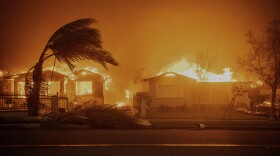America's schools can install "safety pods" at a cost of $15,000 to $30,000 per typical classroom. The pods are National Safety Shelters' answer to school shootings and extreme weather.
"The pods were originally manufactured as tornado shelters for schools located in 'tornado alley' which now encompasses roughly one third of the U.S. and seems to be expanding," Dennis Corrado, the company's president, said in an email to NPR. "After the Sandy Hook tragedy in December 2012, the shelter design was modified ... with the intent of offering them to schools as a dual-purpose safety measure to protect from tornadoes and active shooters."
Corrado said the pods were modified "using NIJ ballistic Level III steel making them resistant to handguns, shotguns and semi-automatic high-caliber weapons including AR-15 and AK-47 assault rifles."
But as details of the pods, as well as their use in an Arkansas school district, were publicized, the internet had some critical things to say.
The Quitman School District in Arkansashas promoted its use of these pods.
The district says on its Facebook page, "Quitman Schools is a proud partner of National Safety Shelters! Student safety is our top priority, and that is why every classroom on the Quitman campus is equipped with a military grade, ballistic steel shelter capable of withstanding an F5 Tornado."
Teachers and administrators also shared testimonials in support of the product, saying it gave them and their students peace of mind.
(National Safety Shelters says the district was not provided any compensation or discounts for the pods or for providing staff members' testimonials on the company's website.)
Amy Klinger, a school safety expert and the director of programs for the Educator's School Safety Network, thinks this kind of product is indicative of a wider problem.
"The problem is that we tend to respond to events, like the tragedy in Uvalde, with a quick solution. Let's do a quick fix. Let's buy something really fast," she said. "And we tend to look at something shiny and go, 'Hey, let's buy that thing.'"
In Uvalde, Texas, a gunman killed 19 students and two teachers at Robb Elementary School in May. Since that shooting, revelations about slow police action and faulty door locks have been published.
"So having a fancy mechanism wouldn't have changed anything," Klinger said of the Uvalde school shooting. "So I think that's the problem with buying stuff. It makes people feel better, but it actually makes your school less safe because it creates the illusion of safety when you don't really have it."
As a longtime school safety educator, Klinger says schools end up purchasing an item over much-needed and desired training for staff and teachers. She says schools should favor what she calls "an all-hazards approach to school safety."
"You can buy things, but if nobody knows how to use them, and no one knows what to do with them, or no one is aware that they exist, then they didn't do any good," she said.
The safety pods "look great" for situations like tornadoes, she said, but what about safety situations that go beyond that? Like if a student is having an allergic reaction, or if a bomb goes off in the hallway, or if a teacher drops dead in the classroom, she said. In those situations, training will be the only thing to help anyone in the important moments following those scenarios.
Corrado said the safety pods are part of a "multi-layered approach" to school safety. Front-end prevention includes blocking shooters from entering a school campus in the first place. The back-end solutions are a safety net, should those front-end methods fail.
"We feel our safety pods provide this safety-net and give those protected a peace of mind not matched by most other measures since near-absolute protection is immediately available to those whose lives are threatened," Corrado said.
Klinger thinks it is essentially "making money on the backs of the fear that people have. We have been prioritizing the wrong things over and over and over and then wondering why nothing changes."
Copyright 2022 NPR. To see more, visit https://www.npr.org. 9(MDAzMjM2NDYzMDEyMzc1Njk5NjAxNzY3OQ001))







